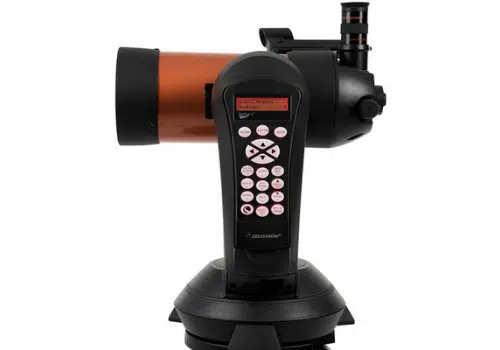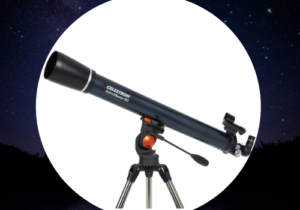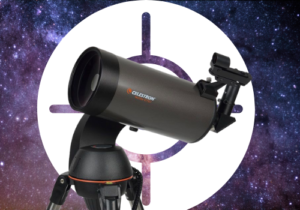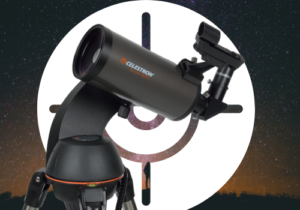Celestron NexStar 4SE Review: Is It Worth Buying?
Disclosure: This post contains affiliate links and I may earn a small commission (at no extra cost to you) if you click through and make a purchase. Thanks in advance – I really appreciate it!
When you want to find celestial objects in the night sky, you need a good-quality telescope to do so. The Celestron Nexstar series has some of the most celebrated GoTo telescopes in recent years, with the 4SE being the cheapest of the SE models available. But how good is the 4SE, and is it really worth it?
The NexStar 4SE has a 4” aperture and slow focal specs in a Maksutov-Cassegrain optical design. There are some advantages to this, but it’s not without its drawbacks.
Let’s find out everything there is to know about this powerful, compact & portable telescope.
My Verdict
If you are in the market for an amazing high-tech computerized telescope on the lower end of the price point then the Celestron NexStar 4SE Computerized Telescope is an amazing choice. It’s an amazing ‘grab and go’ telescope. It is lightweight, easy to set up, and simple to use. The optics are high quality but the smaller aperture and slow focal length mean it performs best for bright objects like the planets, moon, and double stars. It’s a great choice if you want to dabble into some short exposure astrophotography. Of course, there are some limitations too, the 4SE telescope is built mainly for planetary and moon observations. Its aperture and field of view are limiting factors, and many deep-sky objects in its 40,000 object database will not fit in its field of view, or they are very faint to see any details with a 4-inch aperture. Yet it delivers all the aspects a beginner would need to enjoy the night sky.
Pros
- High-end materials and craftsmanship
- A lot of features for a very moderate price
- Fully computerized go-to mount system
- Great for beginners
- Very sharp optics
- No collimation required
- Compact and lightweight
- Limited astrophotography
Cons
- Small aperture
- Small maximum field of view
- Only 1 included eyepiece
- Drains batteries quickly
- Design type: Maksutov-Cassegrain
- Aperture: 102 mm (4 inches)
- Focal Length: 1325 mm
- Focal Ratio: f/13
- Max useful magnification: 240x
- Mount type: Alt-azimuth with GoTo capabilities
- Weight: 11 lb
Prices pulled from the Amazon Product Advertising API on:
Product prices and availability are accurate as of the date/time indicated and are subject to change. Any price and availability information displayed on [relevant Amazon Site(s), as applicable] at the time of purchase will apply to the purchase of this product.
Celestron NexStar 4SE Review
The Celestron NexStar 4SE is the smallest sibling among the other SE series telescopes. The other telescopes with larger aperture sizes in this series are NexStar 5SE, NexStar 6SE, and NexStar 8SE.
Each model is a catadioptric telescope, which cleverly combines mirrors and lenses to squeeze a long focal length into a short tube.
I should also tell you that out of all its siblings, only the 4SE is a Maksutov-Cassegrain design, whereas all the other telescopes in the SE series are Schmidt-Cassegrains.
The focal length of the NexStar 4SE is 52”, which is quite a lot considering the size of its optical tube which is just 13.5”.
Telescopes with longer focal lengths typically provide higher magnifications so tend to be perfect for viewing the moon and planets than deep-sky objects such as Nebulae & star clusters.
The NexStar 4SE telescope, from Celestron, offers star gazing enthusiasts a unique combination of portability and power.
Easily carried, assembled, and disassembled, this telescope sports Celestron’s distinctive single fork arm to hold the company’s characteristic orange scope.
Celestron NexStar 4SE: Optical Performance
Phenomenal Optics
As I mentioned before, the NexStar 4SE is a Maksutov-Cassegrain telescope also known as a Mak or a Mak-Cass for short.
It’s a catadioptric telescope that incorporates a long focal length with a much shorter tube length, spherical mirrors, and corrector lenses.
The Maksutov-Cassegrain design of this telescope eliminates the aberrations that crop up in refractors while giving us the power of a reflector without all of the fragility and hassle that true reflectors occasionally display.
The 4SE offers a solid amount of light gathering capability with the 4” primary aperture.
This makes it about twice as powerful as some of the cheaper telescopes on the market. It gives plenty of magnification power at 240x max zoom.
Its 4-inch aperture is matched by a 1325mm focal length, which gives it a focal ratio of f/13.
The 4SE also has an integrated flip mirror at the back of the telescope. It is used to switch between the diagonal with the eyepiece and the opening for a camera, which you can attach to do some astrophotography.
Like the other options in the Nexstar SE range, it’s built from high-quality materials and is made to last.
It uses Starbright optical coatings to ensure that your view quality is high and bright enough for you to see clearly.
Although it is fairly light, it’s still quite a robust telescope that isn’t going to be broken easily.
What Can You See With NexStar 4SE?
The 4SE shines primarily on the Moon and planets. This telescope is designed to excel with bright objects.
You can easily see lunar details just a few miles across, as well as the phases of Venus and Mercury.
I basically managed to see all of the planets with my NexStar 4SE. I even saw both Uranus and Neptune when they were available.
To make the most of its capabilities, it is definitely worth investing in a couple of smaller eyepieces to get medium and high magnification views of the moon, Jupiter and Saturn.
You can easily see Jupiter’s cloud belts, polar and equatorial zones, and Great Red Spot, and its four largest moons.
When it comes to deep-sky objects, the 4SE’s performance is limited. You can see the brighter DSOs such as the Andromeda galaxy & the Orion nebula.
The 4SE performs very well with double stars, as they are generally rendered clear and sharp with good color.
Mount Capabilities
1. Computerized Mount

The mount is a single fork arm sat atop a sturdy steel tripod with 2” diameter legs.
Those big legs make it a reliable, unshakeable platform for the small telescope atop.
The computerized mount is a great feature of this telescope. Just enter the planet you want to see, and it will automatically point to it and keep it in the field of view, tracking it and compensating for the earth’s rotation.
This means that the only work you will have to do is to map out what objects you want the telescope to find for you and then wait for it to find them.
The telescope is able to do this because of Celestron’s proprietary SkyALign technology.
2. SkyAlign Technology
The SkyAlign technology is one of the most appealing features of the NexStar 4SE as it complements the telescope’s easy setup.
The SkyAlign technology allows the telescope to automatically align itself when directed at three points in the sky.
All you have to do is point it at three bright objects in the sky. This can be as easy as pointing it at Orion, the moon, and Sirius for example.
You’ll have to enter the date, time, and your location, and soon the telescope will process this information and it will locate itself in the world.
Next, you can view any of the 40,000 objects in the telescope’s massive database, obviously if they are available that night.
Let’s discuss more on this awesome database.
3. Hand Controller & Database
The 4SE’s computerized automated technology is packed into a convenient hand control.
This remote is what controls the motorized movement of the mount that allows the OTA to automatically slew to objects in the sky.
It allows access to a 40,000 object database, multiple alignment options, and nine slew speeds.
This means once the telescope has aligned itself it has access to a database that can find tens of thousands of objects to show you.
All you have to do is use the hand control and search and choose an object that you want to see.
Once you’ve chosen a sky object, the telescope will automatically slew itself, find the object, focus on it, and give you the best view possible.
That’s how easy and time-saving it is to use this telescope.
Frankly, a good many of those objects are beyond the practical range of this telescope because of its 4” aperture size.
And do the math: You’d have to observe more than ten objects every night of the year for more than ten years in order to see each one only once!
Prices pulled from the Amazon Product Advertising API on:
Product prices and availability are accurate as of the date/time indicated and are subject to change. Any price and availability information displayed on [relevant Amazon Site(s), as applicable] at the time of purchase will apply to the purchase of this product.
The Celestron NextStar 8SE has been featured in the following articles:
Built-In Equatorial Wedge
The mount has DC servo motors on both axes that provide computerized alt-azimuth movement. Celestron also provides a built-in wedge.
Quite frankly, you will probably never use it.
It is complicated to set up, and polar align. It doesn’t have the polar scope, which makes it even harder. You need the equatorial mount for long-exposure astrophotography, which, unfortunately, this telescope and mount are not made for.
Powering the NexStar 4SE
The telescope is powered by 8 AA batteries you have to place in a nice hidden battery compartment on the mount.
The problem with the computerized mount is that it eats up the 8AA batteries pretty quickly.
So I would highly recommend having a DC power adapter or Celestron’s PowerTank with the motorized mount if possible.
NexStar 4SE Magnification Levels
Because of the Maksutov Cassegrain design, the 4SE can provide high magnifications. Magnification is calculated by dividing the focal length of the telescope by the focal length of the eyepiece.
The 4SE comes only with one eyepiece with a focal length of 25mm. It is a Plossl eyepiece providing 55x magnification.
It is not a lot, and this telescope can handle higher magnification, so I recommend buying an additional smaller eyepiece for higher magnification.
The highest useful magnification for the Celestron Nexstar 4SE is 240x, so I recommend buying a 9mm or 6mm eyepiece (Amazon link) to get higher magnification.
Also, having a good Barlow lens (Amazon link) will double your eyepiece collection and will provide more magnification options with one eyepiece.
Below is a table that shows the magnification that you can get with extra eyepieces and a 2x Barlow lens.
| Eyepiece: | 25mm | 18mm | 10mm |
|---|---|---|---|
| Magnification: | 81x | 113x | 203x |
| With 2x Barlow: | 136x | 226x | 406x |
Portability
The NexStar 4SE combines powerful star gazing capabilities with a compact and portable size.
The mount head weighs 7 lbs (3.2kg), and the tripod adds a further 10 lbs (4.5kg). The telescope itself weighs 6 lbs (2.7kg), so the whole setup comes in at 23 lbs or 10.4 kg.
In addition, the scope can be broken down into multiple pieces to make the scope smaller and easier to pack and transport.
Setup outside can take less than 10 minutes from start to finish, allowing you to take advantage of brief periods of star gazing availability.
The 4SE is so small and light, and the tripod folds so easily, you can quickly jump into almost any vehicle and drive to find dark skies.
And someday, if you grow into a larger telescope, you’ll probably want to keep this one as a “grab-and-go” scope.
Astrophotography
If you are interested in astrophotography, the Celestron NexStar 4SE telescope is a low-budget, entry-level solution for short exposure astrophotography.
If you incorporate the built-in wedge to polar align for EQ movement, you potentially have more astro imaging possibilities to explore, for example, long exposures.
You can take excellent lunar, planetary, and DSO photographs even with its limiting 4” aperture.
The only questionable aspect is the mount’s payload capacity. So make sure that you only use smartphone cameras and lightweight CCD web cameras to photograph the night sky using NexStar 4SE.
Along with its payload capacity, the 4SE’s f/13 focal ratio, mediocre tracking capabilities, and the alt-az nature of the mount do not allow for good long exposure photos.
This telescope is not for you if you are looking for deep sky astrophotography of nebulae and galaxies.
But the NexStar 4SE does well at lunar and planetary astrophotography.
Included Accessories
As well as the OTA, motor drive and mount, Celestron include a red dot finderscope and 25mm ExCel Plössl eyepiece in the box, as well as software and connector lead that enables a PC to control the telescope’s GoTo motor.
Celestron NexStar 4SE: Limitations
Telescopes work by gathering light and the more light they collect, the more objects and details we can see. Unfortunately, the 4-inch aperture of this telescope is too small to reveal most of the objects in the database, especially under light-polluted skies.
In summary, this scope is for you if your interest is seeing details of the moon and planets and even double stars, which it splits well.
The telescope also lacks a power supply source. The mount drains away 8 AA batteries rather quickly and even the rechargeable options don’t last long.
As I mentioned before in this article, if you want to properly use this telescope, you will need to get an external power supply.
This could either be an AC Adapter or a Powertank.
Should I buy the Celestron NexStar 4SE?
As with everything in this world, this telescope has its pros and cons too. But the Nexstar 4SE doesn’t really have any major issues that may lead you to regret buying it.
It’s true that because of its 4” aperture it cannot see most of the 40,000 sky objects in its database, but it’s an amazing telescope to see the Moon and almost all the planets.
Quite frankly, out of all the telescopes in the Nexstar SE lineup, Nexstar 8SE is the only one that can effectively use the entirety of the massive database.
Some users have reported facing standard software hiccups but most users have not faced any issues with the telescope’s computer, so the problem isn’t widespread.
Moreover, Celestron keeps releasing new updates frequently, so the technology is only going to get better with fewer and fewer glitches.
Also, Celestron offers unlimited technical support as well as a 2-year warranty on the telescope so any issues you encounter of this nature should theoretically be able to be resolved by contacting Celestron.
I have never faced any issue with this telescope that was serious enough for me to contact tech support.
Conclusion
All in all, the Celestron 4SE is a great option for both beginner astronomers and intermediates who want a telescope that is really easy and simple to use.
Of course, its 4-inch aperture means that it’s not going to be able to see very deep-sky objects, however, it isn’t really intended for that kind of use.
But if your budget allows, and you don’t mind bigger and havier scope, buy the higher SE model like Nexstar 6SE or Nexstar 8SE, which are much better telescopes.
Written by:

Jason Parnell
At 15, I sold my bike to buy my first telescope. I spent the next 3 years sketching as many Messier objects as I could find from my garden, then at the age of 18, I discovered beer. I have wandered through California's Mojave Desert with other amateur astronomers in search of the best stargazing experience.
ABOUT US
We are a team of active amateur astronomers, here to help you with all your astronomy and science related needs – this is anything, from reviewing the latest telescopes to be released to talking about gravity and neurons. The Big Bang Optics was started because of our love for astronomy and to help others like us find the best telescope and accessories.
LEGAL DISCLAIMER
The Big Bang Optics is a participant in the Amazon Services LLC Associates Program, an affiliate advertising program designed to provide a means for sites to earn advertising fees by advertising and linking to Amazon.com. The Big Bang Optics also participates in affiliate programs with Clickbank and other sites. The Big Bang Optics is compensated for referring traffic and business to these companies.





